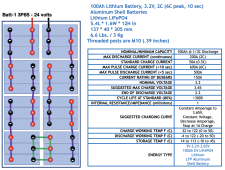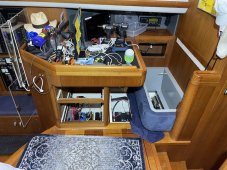BillCaswell
New Member
- Joined
- Jan 10, 2020
- Messages
- 78
Hello All,
Due to the access to the battery box in my sailboat, I am working through plans to build 4 battery packs. Each pack will be configured for 24 volts and consist of 24 Fortune cells. 4 batt packs x 24 cells/pack = 96 cells. The attached diagram shows my thinking on how to wire each cell together for a 24 volt configuration that will easily fit through the access under the nav station. The size of the battery pack is similar to the LifeLine 8D size batteries. The weight is similar so the pulley system (not shown) will work.
I am looking for some suggestions: (I'm peddling as fast as possible to come to speed... including searching the DIY forum for previous discussions)
- Does this arrangement of 3P8S look correct? I found some examples online so followed the same pattern.
- Each cell can produce 2C or 200 amps continuous. Does 3P8S mean that each battery will provide 600 amps continuous at 24 volts?
- Is my thinking correct that I need to find cells-to-cell bus bars that can handle 200 amps or do I need to use higher capacity bus bars because the batteries will provide 6C peak for 10 seconds? Suggestions?
- I plan to use contactors controlled by a BMS to protect each battery. I am looking at the REC BMS with their slave units unless there are other recommendations to look at? I have been reading the DIY Solar forums and am overwhelmed by the many choices and people suggesting their favorite BMS.
- Lastly, because I need to lower each battery down into the battery box, I need to make boxes for each of the four battery groups. I'm trying to decide between aluminum, 316 stainless steel as each battery will weigh nearly 160 lbs. Thoughts and any suggestions for sourcing the boxes other than going to a local metal fabricator?
- I want to use as much UL components as possible, making sure to build these packs to ABYC and USCG standards. Does anyone have experience with this? Gotchas or advice?
- I am repeating some of the same questions from my thread in the Beginners Forum but I think that I've made progress in my understanding, so wanted to post in this thread where I saw similar questions.
Thanks in advance for any guidance or suggestions!


Due to the access to the battery box in my sailboat, I am working through plans to build 4 battery packs. Each pack will be configured for 24 volts and consist of 24 Fortune cells. 4 batt packs x 24 cells/pack = 96 cells. The attached diagram shows my thinking on how to wire each cell together for a 24 volt configuration that will easily fit through the access under the nav station. The size of the battery pack is similar to the LifeLine 8D size batteries. The weight is similar so the pulley system (not shown) will work.
I am looking for some suggestions: (I'm peddling as fast as possible to come to speed... including searching the DIY forum for previous discussions)
- Does this arrangement of 3P8S look correct? I found some examples online so followed the same pattern.
- Each cell can produce 2C or 200 amps continuous. Does 3P8S mean that each battery will provide 600 amps continuous at 24 volts?
- Is my thinking correct that I need to find cells-to-cell bus bars that can handle 200 amps or do I need to use higher capacity bus bars because the batteries will provide 6C peak for 10 seconds? Suggestions?
- I plan to use contactors controlled by a BMS to protect each battery. I am looking at the REC BMS with their slave units unless there are other recommendations to look at? I have been reading the DIY Solar forums and am overwhelmed by the many choices and people suggesting their favorite BMS.
- Lastly, because I need to lower each battery down into the battery box, I need to make boxes for each of the four battery groups. I'm trying to decide between aluminum, 316 stainless steel as each battery will weigh nearly 160 lbs. Thoughts and any suggestions for sourcing the boxes other than going to a local metal fabricator?
- I want to use as much UL components as possible, making sure to build these packs to ABYC and USCG standards. Does anyone have experience with this? Gotchas or advice?
- I am repeating some of the same questions from my thread in the Beginners Forum but I think that I've made progress in my understanding, so wanted to post in this thread where I saw similar questions.
Thanks in advance for any guidance or suggestions!



Last edited:



